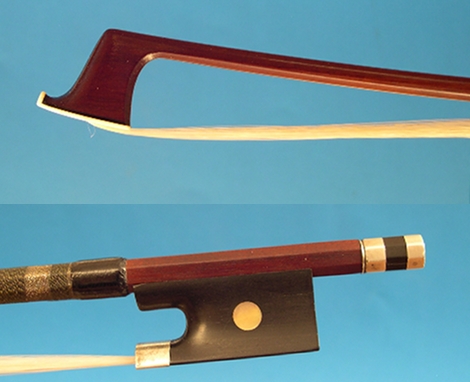JEAN ADAM AKA "LE GRAND ADAM"
Following nor the Gregorian, neither the Republican calendar , this latter much loved by French revolutionaries, but the Vuillaume's one , this week's post should be dedicated to Nicolas Maline. In a chronological order, he arrived first by J.B.V. 's workshop , but unfortunately I was unable to collect any photo of his bows so I hope to succeed in it next week. So, now: Le Grand Adam !

Violin bow with ebony button without coulisse and slide
A turbulent guy, Grand Adam, so called to distinguish him from his grandfather, was born in Mirecourt by Jean Dominique Adam and Anne Deroux on February 23, 1823.
Son and grandson of bowmakers , he begins his job when he was twelve years old in his father's workshop, where he remains until 1842. In the early periods of his activity , the style of his heads is very close to his father and Fonclause's style in particular, while as far as the frogs are concerned you can clearly see F.X. Tourte's influence.
He was a very lively boy, so he was sent to Paris, probably after some bravadoes that brought him a day in prison. On December 18, 1841 he was arrested for the following reason: "Déclaré coupable de violence, coups et tapage nocturne. " As if to say: "Tonight you sleep by us, tomorrow morning when the hangover is off, you will be sent home. " But it was not his fault, if you do not drink wine, you are not allowed to enroll in the bowmakers list !
Apart jokes, whern he arrives in Paris, he has the opportunity to work alongside the Great names of bowmaking. I recall you that in Vuillaume's workshop all big names passed by and, even after leaving it , they maintained close trade relations with him. At this time Grand Adam tries, partially succeeding , to refine his style, changing the heads in particular, that start to assume Tourtian echoes.
In 1850 he opens his own business in Paris and two years later, in 1852 , he marries Marguerite Hector. From this marriage they have only one child, Nicolas, who will become a bowmaker as well, even of no significant importance, and who will work for Louis Bazin, among the others.
In 1853 he comes back to Mirecourt and reopens his workshop , going on trading with Vuillaume. In these years his stylistic choices are leaned towards Peccatte-Simon. His main production belongs to this time, although if we must consider that, in his Parisian years, he worked almost exclusively for Vuillaume and often it is not easy to move among the various craftsmen who built for him.
He will continue to work until his early death, occurred in 1869, when he was only forty-six, and even if less refined than other ones ,he left behind him a GRAND number of excellent bows able to compete, for mechanic and sound , with those of his Masters.
The style

Violin bow with ebony and silver with silver winding on silk.
Rather than stylistic made by Grand Adam, one can rightly speak of influences. As already mentioned, early in his career, he is followed by his father, who despite being a good craftsman was in no way able to teach him the small big secrets of the Parisians. Initially he inspired by Fonclause's heads and by Tourte for frogs and buttons.
For example the bow here displayed has the head and frog so highly inspired by F.X. Tourte to be even considered as a copy.
The opening one is a multi hybrid. The slope of the ridge recalls Tourte, steeper and with a massive arrival on the house. The bevel starts as very large and important and decreases on the arrival in a Pecatte style.
The frog does not have a metal coulisse and recalls the early Fonclause; that one of Pajeot's years, so to to speak. Grand Adam has created frogs with coulisse, as witnessed by the second picture, but due to the increased cost of both time and money to build them, he often preferred the rough ebony.
Jean GRAND Adam is rightly recognized as one of the best bowmakers of his generation, although as I said, he could never remove his father's imprinting. His head and frogs are certainly full of character, moreover,they are very similar to those by Dominique Peccatte whom he copied for much of his life. His stroke is , however, less refined and rougher.
Grand Adam the "rough", as I dared to nickname him.
So long
Paolo
|
 
 |